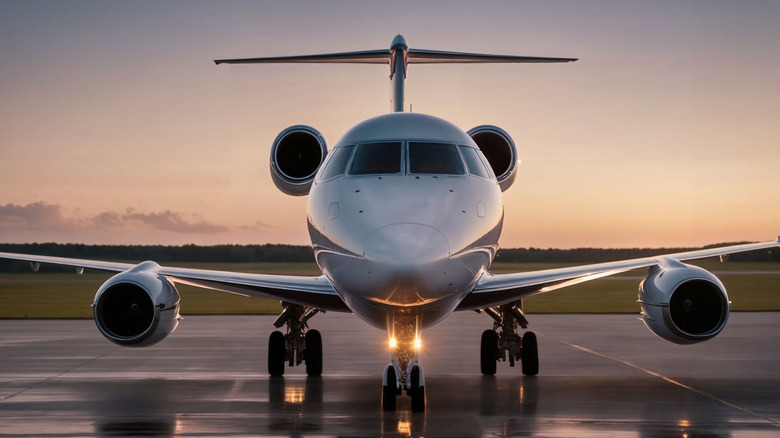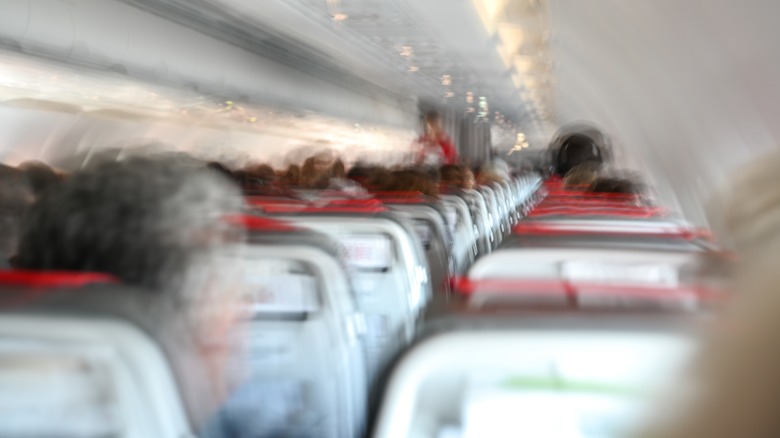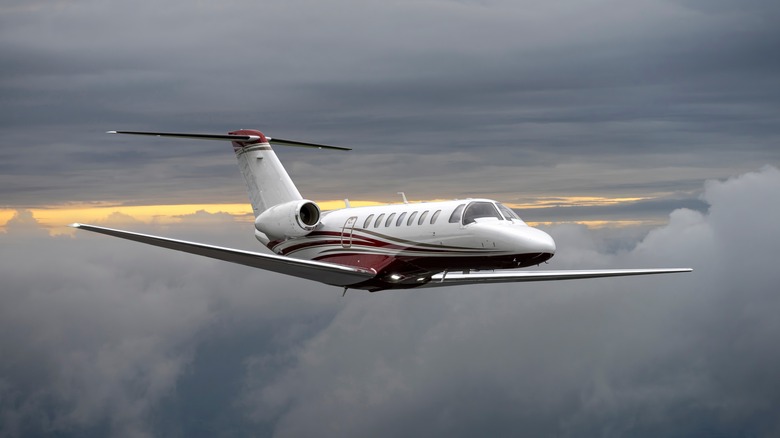Do Private Jets Face More Or Less Turbulence Than Commercial Planes?
Turbulence is an unavoidable facet of flying, but does it jostle a 12-seat Gulfstream harder than a 200-seat Boeing? For anxious flyers, that distinction matters. However, first let's smooth the ride and say that injuries resulting from turbulence are incredibly rare. According to the Federal Aviation Administration (FAA), there were 184 serious injuries attributed to turbulence between 2009 and 2023. While this might sound like a high figure, it's worth noting that each day 2.9 million passengers take to America's skies. In short, the chances of being injured in a turbulence-related incident are minimal, regardless of whether your buckled into economy or reclining in a private cabin.
There are two big factors that decide which is the bumpier ride. The first is the size of the jet, private jets are considerably smaller than their commercial counterparts and this has a bearing on the turbulence levels (think being out in a choppy ocean in a powerboat then traversing the same conditions in a cruise liner). However, it's not the only factor. Private jets generally fly at higher altitudes than commercial jets and this has the advantage of taking them above the worst of the turbulence. So, the answer is more complicated than just saying yes or no. To help get a better handle on the subject, a useful starting point is to look at just what turbulence is and how it can affect aircraft.
What is turbulence
Turbulence happens to a plane when it's buffeted by a sudden up or downdraft of wind. It's these gusts of wind that cause the rapid changes in height and the subsequent sudden jolts that most passengers will have experienced. This type of turbulence is worsened in stormy weather and while a 400 ton passenger jet has all that mass to help cushion the ride, an 18 ton private jet like the Embraer Phenom is going to have a bumpier ride for sure. This is why pilots will avoid flying in extreme weather wherever possible. On the plus side, this is easier to do in smaller and more agile private jets.
The picture changes at higher altitudes, private planes fly higher than commercial planes (often close to or over 50,000 feet), this burns less fuel, places the plane in less congested airspace, and — importantly — lifts them above the worst of the weather. For private jets there is a downside to this, while these altitudes will lessen much of the "weather-induced" turbulence common at lower altitudes, it does lift them into the realm of another type of turbulence – clear air turbulence (CAT). CAT is often associated with the jetstream, a fast, high-altitude, wind phenomenon that generally occurs between 40,000 and 60,000 feet. However, CAT can also happen at lower altitudes through other atmospheric instabilities. The good news is that while the effect of turbulence will be worse for private jets, their agility and greater freedom to set routes means they can do more to avoid it.
Is turbulence getting worse?
Let's begin on a positive note, air travel is still the safest form of transport and the safety of private jets contributes to this encouraging stat. However, there is a growing body of evidence that turbulence has become more frequent and severe as a result of climate change. A recent incident of severe turbulence on a Singapore Airlines flight which resulted in the tragic death of a passenger highlights how concerning this is. Among the evidence pointing at increased turbulence levels is a study published on the American Geophysical Union website, which found that CAT instances rated at severe or greater had risen by 55% in the skies over the North Atlantic and the US since 1979. The underlying cause is thought to be climate change. Although, as reported by the BBC, the fact that we're flying more and pilots have less opportunity to avoid turbulence due to crowded airspace could also have a bearing. A point that isn't as relevant for private jets, which have more freedom to avoid congested airspace.
Ultimately, on any type of plane, it's sensible to keep your seatbelt on whenever possible. Unlike their fragile cargo, private jets are designed to withstand even severe turbulence, as one pilot noted – "crashing from turbulence has the same likelihood of me stepping outside the door and having a meteorite land on my head." Pretty good odds and for those lucky enough to fly on a private jet it means they can sit back and enjoy the ride — even if it does get a little choppy.


